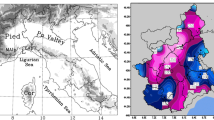Summary
A semi-implicit non-hydrostatic mesoscale forescasting model, which is used operationally in the United Kingdom Meteorological Office, has been reformulated using two time levels and semi-Lagrangian advection so as to permit longer timesteps. The boundaries are found to be an important influence on the model's stability and two methods of suppressing wave reflection are described with the aid of a one-dimensional experiment. The model's responses to two dimensional flow over a ridge and to three-dimensional flow over an isolated mountain are then demonstrated. The reformulated model is more efficient than the original provided a timestep at least twice as long can be used. It is also superior both in having minimal damping (except at the boundaries), and in the accuracy of the advection scheme.
Similar content being viewed by others
References
Ballard, S. P., Golding, B. W., Smith, R. N. B., 1991: Mesoscale model experimental forecasts of the Haar of North East Scotland.Mon. Wea. Rev.,119, 2107–2123.
Bates, J. R., 1984: An efficient semi-Lagrangian and alternating directions implicit method for integrating the shallow water equations.Mon. Wea. Rev.,112, 2033–2047.
Bourke, W., McAvaney, B., Puri, K., Thurling, R., 1977: Global modeling of atmospheric flow by spectral methods.Methods in Comp. Phys.,17, 267–324.
Carpenter, K. M., 1979: An experimental forecast using a non-hydrostatic mesoscale model.Quart. J. Roy. Meteor. Soc.,105, 629–655.
Clark, T. L., Peltier, W. R., 1977: On the evolution and stability of finite amplitude mountain waves.J. Atmos. Sci.,34, 1715–1730.
Cotton, W. R., Tripoli, G. J., 1978: Cumulus convection in shear flow-Three dimensional numerical experiments.J. Atmos. Sci.,35, 1503–1521.
Cox, G. P., 1988: Modelling precipitation in frontal rain-bands.Quart. J. Roy. Meteor. Soc.,114, 115–127.
Cullen, M. J. P., 1990: A test of a semi-implicit integration technique for a fully compressible non-hydrostatic model.Quart. J. Roy. Meteor. Soc.,116, 1253–1258.
Davies, H. C., 1976: A lateral boundary formulation for multi-level prediction models.Quart. J. Roy. Meteor. Soc.,102, 405–418.
Gjevik, B., Marthinsen, T., 1978: Three dimensional lee wave pattern.Quart. J. Roy. Meteor. Soc.,104, 947–957.
Golding, B. W., 1990: The meteorological office mesoscale model.Meteorol. Mag.,119, 81–96.
Hess, G. D., 1990: Numerical simulation of the August 1986 heavy rainfall event in the Sydney area.J. Geophys. Res.,95D3, 2037–2082.
Klemp, J. B., Durran, D. R., 1982: An upper boundary condition permitting internal gravity wave radiation in numerical mesoscale models.Mon. Wea. Rev.,111, 430–444.
Klemp, J. B., Lilly, D. K., 1978: Numerical simulation of hydrostatic mountain waves.J. Atmos. Sci.,35, 78–107.
Kelmp, J. B., Wilhelmson, R. B., 1978: The simulation of three dimensional convective storm dynamics.J. Atmos. Sci.,35, 1070–1096.
Leslie, L. M., Mills, G. A., Logan, L. W., Gauntlett, D. J., Kelly, G. A., McGregor, J. L., Manton, M. J., Sardie, J. M., 1985: A high resolution primitive equations model for operations and research.Aust. Meteorol. Mag.,33, 11–36.
Marthinsen, T., 1980: Three dimensional lee waves.Quart. J. Roy. Meteor. Soc.,106, 569–580.
McDonald, A., Bates, J. R., 1987: Improving the estimate of the departure point position in a two time level semi-Lagrangian and semi-implicit scheme.Mon. Wea. Rev.,115, 737–739.
Mills, G. A., Seaman, R. S., 1990: The BMRC limited area data assimilation system.Mon. Wea. Rev.,118, 1217–1237.
Miyakoda, K., Rosati, A., 1977: One-way nested grid models: The interface conditions and numerical accuracy.Mon. Wea. Rev.,105, 1092–1107.
Orlanski, I., 1976: A simple boundary condition for unbounded hyperbolic flows.J. Comp. Phys.,21, 251–269.
Peltier, W. R., Clarke, T. L., 1983: Nonlinear mountain waves in two and three spatial dimensions.Quart. J. Roy. Meteor. Soc.,109, 527–548.
Redelsperger, J. L., Sommeria, G., 1986: Three-dimensional simulation of a convective storm: sensitivity studies on subgrid parameterization and spatial resolution.J. Atmos. Sci.,43, 2619–2635.
Roach, W. T., Slingo, A., 1979: A high resolution infrared radiative transfer scheme to study the interaction of radiation with cloud.Quart. J. Roy. Meteor. Soc.,105, 603–614.
Robert, A., 1969: The integration of a spectral model of the atmosphere by the implicit method. In: Proc. WMO/IUGG Symposium on Numerical Weather Prediction. Tokyo:Japan Met. Agency,VII, 19–24.
Robert, A., 1981: A stable numerical integration scheme for the primitive meteorological equations.Atmos.-Ocean.,19–1, 35–46.
Robert, A., 1992: Bubble convection experiments with a semi-implicit formulation of the Euler equations.J. Atmos. Soc. (To appear).
Robert, A., Yee, T. L., Ritchie, H., 1985: A semi-Lagrangian and semi-implicit numerical integration scheme for multilevel atmospheric models.Mon. Wea. Rev.,113, 388–394.
Rutledge, S. A., Hobbs, P. V., 1983: The mesoscale and microscale structure and organisation of clouds and precipitation in midlatitude cyclones VIII: A model for the seeder-feeder process in warm frontal rainbands.J. Atmos. Sci.,40, 1185–1206.
Rutledge, S. A., Hobbs, P. V., 1984: The mesoscale and microscale structure and organisation of clouds and precipitation in midlatitude cyclones XII: A diagnostic modelling study of precipitation development in narrow cold frontal rainbands.J. Atmos. Sci.,41, 2949–2972.
Smith, R. B., 1979: The influence of mountains on the atmosphere.Adv. Geophys.,21, 87–226.
Somieski, F., 1988: Mesoscale model parameterizations for radiation and turbulent fluxes at the lower boundary. DFVLR-FB-88-48.
Staniforth, A., Cote, J., 1991: Semi-Lagrangian integration schemes for atmospheric models—A review.Mon. Wea. Rev.,119, 2206–2223.
Strang, G., 1969: On the construction and comparison of difference schemes. SIAMJ. Num. Anal.,5, 506–517.
Tanguay, M., Robert, A., Laprise, R., 1990: A semi-implicit semi-Lagrangian fully compressible regional forecast model.Mon. Wea. Rev.,118, 1970–1980.
Tapp, M. C., White, P. W., 1976: A non-hydrostatic mesoscale model.Quart. J. Roy. Meteor. Soc.,102, 277–296.
Temperton, C., Staniforth, A., 1987: An efficient two time level semi-Lagrangian semi-implicit scheme.Quart. J. Roy. Meteor. Soc.,113, 1024–1039.
Tripoli, G. J., Cotton, W. R., 1982: The Colorado State University three-dimensional cloud/mesoscale model-1982. Part 1: General theoretical framework and sensivity experiments.J. Rech. Atmos.,16, 185–219.
Williamson, D. L., 1990: Semi-Lagrangian moisture transport in the NMC spectral model.Tellus,42A, 413–428.
Williamson, D. L., Rasch, P. J., 1989: Two dimensional semi-Lagrangian transport with shape preserving interpolation.Mon. Wea. Rev.,117, 102–129.
Author information
Authors and Affiliations
Rights and permissions
About this article
Cite this article
Golding, B.W. An efficient non-hydrostatic forecast model. Meteorl. Atmos. Phys. 50, 89–103 (1992). https://doi.org/10.1007/BF01025507
Received:
Revised:
Issue Date:
DOI: https://doi.org/10.1007/BF01025507




